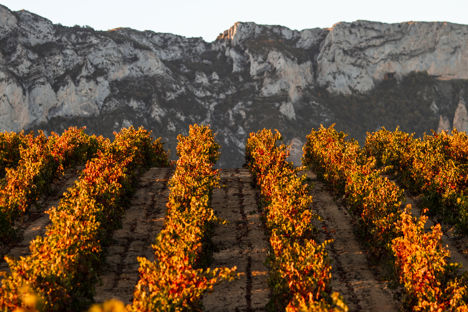
The wine regions of Spain: La Rioja
One of Spain’s most famous wine regions, La Rioja may be best known for producing red wines but it’s also increasingly earning a reputation for its whites. We take a closer look at this renowned yet constantly evolving wine region.
The wine regions of Spain: La Rioja
One of Spain’s most famous wine regions, La Rioja may be best known for producing red wines but it’s also increasingly earning a reputation for its whites. We take a closer look at this renowned yet constantly evolving wine region.
Like many of the famous wine regions of Europe there’s evidence that wine making has been going on in La Rioja since Roman times. The industry gained a stronger foothold in the mediaeval period when monasteries began to spring up along the St James Way, all producing wine. By 1520, La Rioja was sufficiently established as a wine region to have many of the makers join forces and agree to label their wines in a similar way as a guarantee of quality, giving birth to an ancestor of the present D.O.Ca. The latest incarnation of the Rioja organisation started life in May 1902 and while most Spanish wine organisations are Denominación de Origen, Rioja became a D.O.Ca Denominación de Origen Calificada in 1991. This made it one of only two wine regions in the whole of Spain to hold this status and means that Rioja wines are subject to even more quality controls and checks than a D.O.
Famous throughout the world, for many people of a certain generation Rioja wine is Spanish wine. Seeing names like Marqués de Cáceres or Beronia while traveling through Spain is a sudden reminder that the wine most of us are familiar with as simply a label on a bottle actually has a geographic location. While we often drink it without thinking, the people behind it spend their lives battling the elements to make sure that their end product is consistently of a high standard.
While Rioja has been a producer of heavily oaked reds since the 19th century, it’s gaining increasing fame for its lighter style of reds and is expanding its production of rosés and whites. White Rioja wine was traditionally made from the Malvasía grape, oaked and heavily alcoholic, but production methods started to change in the 1980s with wineries experimenting to make a lighter, fruitier white wine. Marqués de Cáceres was the first winery in the D.O. to put this style of white Rioja on the market.
As Rioja was at the forefront of a general movement in the Spanish wine world to focus on the indigenous grapes of each region, the most widespread variety used in white Rioja production today is the indigenous Viura grape, also known as Macabeo in other parts of Spain. The D.O.Ca permits a number of other varieties, with the most popular after Viura being Tempranillo Blanco and Verdejo.
While white wine from Rioja makes up only about 10% of the total Riojan production, wine makers have put a lot of effort into experimenting with various techniques and grape varieties to create a distinctive light white Rioja style. The wines are normally released a year after their production, and are mostly zesty, dry and fresh with a slight citrus taste and a million miles away from the traditional Riojan aged reds. It can be a bit of a shock to drink something so light and refreshing as a Muga white when Muga’s famous traditional reds have such a different profile, but it’s made by the same experts with the same depth of knowledge and that same quality is therefore guaranteed.
Rioja Alta is centred around the historic town of Haro. This region is located in the far west of the Rioja wine region and lies south of the Ebro river. Some of the most famous names in Rioja such as Bodegas Muga and López de Heredia have their wineries in this area. The white wine production here mostly involves the indigenous Viura although blends using international varieties are also made.
Rioja Alavesa is the smallest of the three regions. It covers the area north of the Ebro River, Logroño (the capital of the region), and into the Basque province of Alava. The most recognisable Rioja Alavesa wineries are Marqués de Riscal and Bodegas Faustino. Like Rioja Alta, the grape used for its white wine is almost exclusively Viura.
Rioja Oriental stretches southeast from Logroño towards the small town of Alfaro south of the Ebro River, while the remainder is north of the river and in Navarra. This makes it the largest of the three sub regions by far and it actually makes up about 40% of the D.O.Ca production. Rioja Oriental is developing its own personality and using the newest methods of winemaking to further its reputation in wineries such as Palacios Remondo, part of Spanish wine giant Alvaro Palacios. As with the rest of Rioja, the main grape used in white wine here is the indigenous viura but Tempranillo blanco is also worthy of note.

